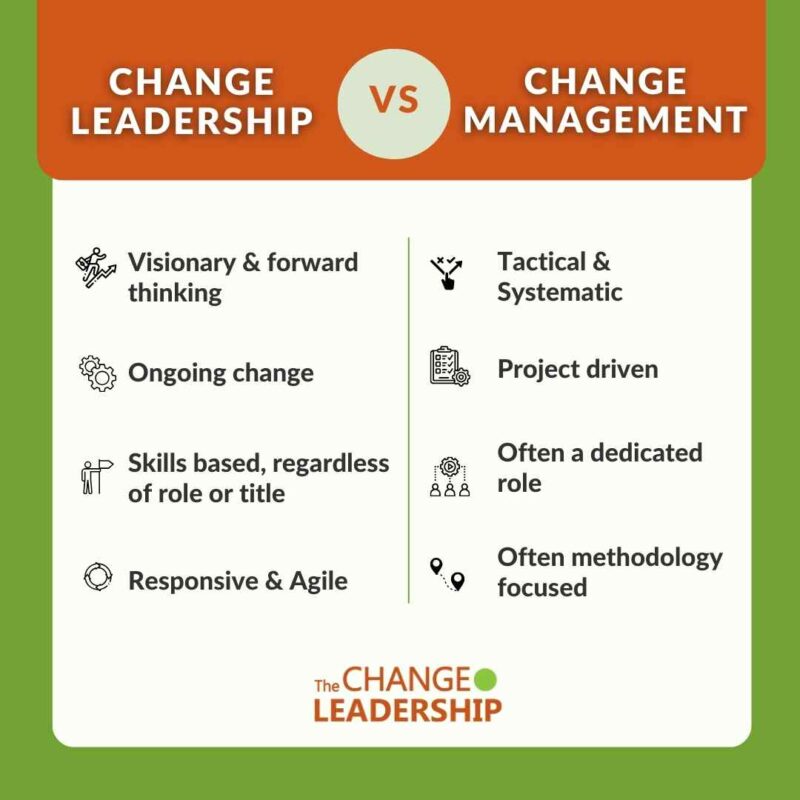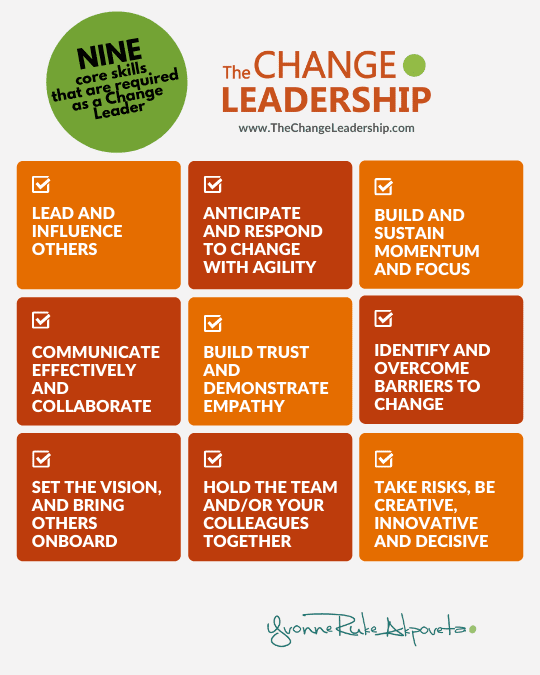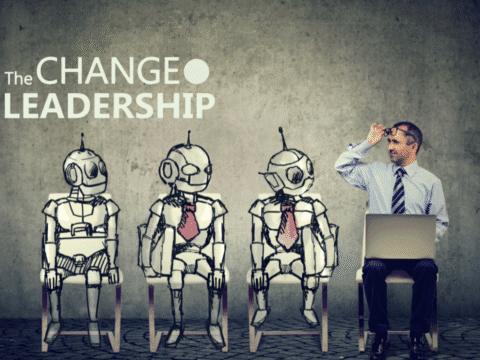Change Leadership Defined, and How it Differs from Change Management
Change Leadership Defined, and How it Differs from Change Management

What is Change Leadership?
In today’s era of continuous disruption, advancing technology, and complex socio-economic shifts, change leadership has evolved into a critical capability for every professional.
Change Leadership is the ability to influence and inspire action in others, and respond with vision and agility during periods of growth, disruption, or uncertainty to bring about the needed change.
(Yvonne Ruke Akpoveta)
This definition reflects a paradigm shift: from viewing change leadership as a skill reserved only for top executives or change managers, to recognizing it as an essential competency across all positions and titles. Change leadership requires leaders — and team members — at every level to be visionary and forward-thinking, while also agile and responsive to a constantly evolving environment.
How the Definition Has Evolved
For many years, one of the most cited definitions of change leadership was by Higgs and Rowland:
“Change leadership is the ability to influence and enthuse others through personal advocacy, vision and drive, and to access resources to build a solid platform for change.”
This remains a valuable foundation, emphasizing influence, vision, and advocacy. But today’s environment demands more. Change leadership now requires forward-thinking vision, agility, and resilience as essential skills for leaders and teams at every level.
Change leadership today goes further. It requires vision and agility not only from executives, but also from managers, project leaders, HR partners, and team contributors across the organization. It is no longer a competence reserved for a few. It is a core organizational capability needed to respond better and faster to continuous change.
How is Change Leadership Different from Change Management?
Change Leadership and Change Management are two terms that are often used interchangeably. Oftentimes, the phrase “Change Management” is employed to describe “Change Leadership” due to the close relationship between the two.
Let’s begin by distinguishing between these two terms.
-
Change Management is the map. It is tactical and structured, providing the processes, timelines, and tools needed to guide a project or initiative from start to finish. Typically linked to specific initiatives with defined start and end dates, change management ensures the practical steps of adoption are followed.
-
Change Leadership is the compass. It is ongoing and directional, focused on setting vision, inspiring action, and navigating uncertainty. Unlike the project-bound nature of change management, change leadership is a capability that extends across roles, levels, and situations, shaping how people and organizations adapt in the face of continuous change.
A Change Leader (representing Change Leadership) is what you evolve into, independent of your role or title, while Change Management delineates tasks you must undertake. It is the difference between charting the course (leading) and steering the ship (managing). Both are necessary, but they serve different purposes.

Why Change Leadership Matters in Today’s Workplace
In today’s disruptive business environment, change is happening at an accelerated speed. Organizations must respond faster and better than ever before. This can only happen when people across all levels are empowered with the change leadership skills and mindset to navigate, lead and respond to change within their sphere of influence.
Today’s world is not only volatile, uncertain, complex, and ambiguous (VUCA). It is also shaped by artificial intelligence, automation, hybrid work, and economic uncertainty. These forces accelerate the need for change leadership as a core competency, not a nice-to-have.
Historically, “change leadership” was considered a competence reserved for top management or designated change managers. That is no longer the case. In our experience working with many organizations, some of the biggest frustrations in change and transformation efforts often stemmed from the absence of change leadership at every level — from individual contributors to senior leadership.
Ultimately, when change succeeds or fails, one factor consistently proves paramount: effective change leadership.
The Change Leadership Role is Expanding
One mistake often made is to assume leadership belongs only to those with a formal title. This leaves many contributors overlooking the influence they already have in driving outcomes for their teams and organizations.
Today, the ability to lead and respond to change is no longer reserved for a select few. It is a core competency for every leader, innovator, project manager, HR partner, and team member who wants to make meaningful impact in their role and organization
McKinsey reports that organizations that invest in leadership and capability building are 2.5 times more likely to succeed in transformation. And according to the Skillsoft 2025 Global Skills Intelligence Survey, only 10 percent of HR and L&D leaders feel confident their people have the skills needed for the next 12–24 months.
The implication is clear: organizations cannot rely on pockets of expertise. To thrive in disruption, change leadership must be built as a widespread competency across the enterprise.
Who is a Change Leader?
A change leader is not defined by a title but by their mindset and behaviours. It is the person who takes ownership of moving change forward, whether they are a CEO, a manager, or a team contributor. Some of the core skills required as a Change Leader include the ability to:

- Setting the vision and bringing others onboard
- Anticipating and responding to change with agility
- Taking risks, being creative, innovative, and decisive
- Holding the team together, motivated and empowered
- Building momentum and staying focused amid disruption.
- Communicating effectively and collaborating across teams
- Leading and influencing across peers, teams, and executives
- Building trust and demonstrating empathy by putting people first
- Leveraging data and technology to inform decisions and drive adoption
- Identifying and overcoming barriers to change with a focus on the big picture
Ask yourself: Are you successfully leading and responding to change in today’s fast-paced and disruptive environment?
Conclusion and Next Steps
Change Leadership is about influencing and inspiring others to act, and having the vision and agility to navigate disruption. It is a critical capability for today’s organizations and individuals alike.
Are you ready to develop your change leadership competencies?
-
Join our free online Change Leadership Community to connect with peers and access resources.
-
Explore our Change Leadership Training and the ACMP-accredited Change Leadership Accelerator. These programs are designed to build capability, resilience, and confidence to lead change in real time. Learn more here.
- Join our mailing list to receive updates on ‘What’s Changing, and What’s New’ directly to your inbox http://bit.ly/JoinTCList

Yvonne is a Change Management Strategist, Catalyst and Change Leadership Advocate who is passionate about working with professionals and organizations to help them to successfully lead change. You can learn more about Yvonne at: www.yvonnerukeakpoveta.com, and also connect with her on LinkedIn, Facebook, Twitter and Instagram.




